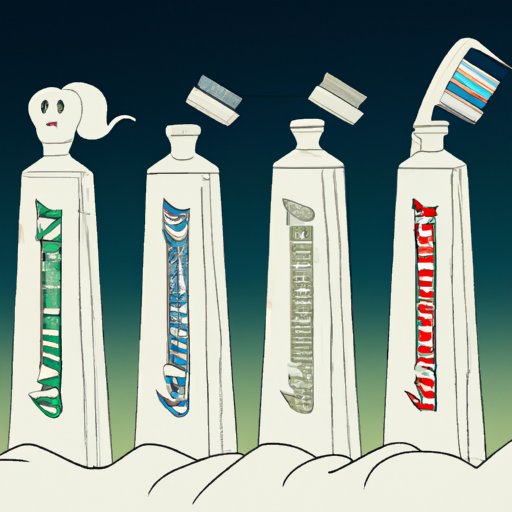Introduction
Toothpaste is a paste or gel used for cleaning one’s teeth, usually containing fluoride and other ingredients to help improve oral hygiene. It is typically sold in a tube, although it can also come in a jar or container. The purpose of this article is to explore the fascinating history behind the invention of toothpaste and how it has evolved over the centuries.

A Historical Look at the Invention of Toothpaste
The use of toothpastes dates back to ancient times, with various cultures throughout history creating their own versions of pastes and powders to clean their teeth. Ancient Egyptians were among the earliest known users of toothpastes, and they created a mixture of powdered ashes and vinegar to clean their teeth. Chinese people used herbal remedies and pastes to keep their teeth clean, while Indians used charcoal, salt and mustard seed.
Throughout the Roman and Greek eras, toothpastes made from ingredients such as honey, dried flowers, and talc were used for oral hygiene. These early toothpastes were often quite abrasive, which could damage the enamel on teeth. By the 17th century, toothpastes were being sold commercially, although these still contained abrasive ingredients.
Exploring the Evolution of Toothpaste Through the Ages
The earliest recorded use of toothpastes was by the ancient Egyptians, who mixed powdered ashes and vinegar to create a paste for brushing their teeth. This paste was thought to have antiseptic and cleansing properties, and it was used to both clean and whiten teeth.
The Romans and Greeks also had their own versions of toothpastes, which were made from ingredients such as honey, dried flowers, and talc. While these pastes were effective at cleaning teeth, they were often too abrasive, which could damage the enamel on teeth.
The development of modern toothpastes began in the 19th century, when soap and chalk were added to the mix. By the end of the century, toothpastes were being sold commercially, and they continued to evolve over the next few decades. In 1895, the collapsible tube for toothpaste was invented, making it easier to store and transport toothpaste.
In the 20th century, major advancements were made in toothpaste formulas. Fluoride was added to toothpastes in 1914, and other ingredients such as baking soda, hydrogen peroxide, and triclosan were added to make them even more effective at cleaning and protecting teeth. Today, there are many different types of toothpaste available, ranging from natural pastes to electric toothbrushes.

How Ancient Cultures Used Toothpaste Before Modern Times
Ancient Egyptians used a mixture of powdered ashes and vinegar to brush their teeth. This paste was believed to have antiseptic and cleansing properties, and it was used to both clean and whiten teeth. Chinese people used herbal remedies and pastes to keep their teeth clean, while Indians used charcoal, salt and mustard seed.
The Romans and Greeks had their own versions of toothpastes, which were made from ingredients such as honey, dried flowers, and talc. These pastes were effective at cleaning teeth, but they were often too abrasive, which could damage the enamel on teeth.
An In-Depth Analysis of When Toothpaste Was First Invented
The development of modern toothpaste began in the 19th century, when soap and chalk were added to the mix. By the end of the century, toothpastes were being sold commercially, and they continued to evolve over the next few decades. In 1895, the collapsible tube for toothpaste was invented, making it easier to store and transport toothpaste.
The first commercial toothpaste was created in 1873 by Dr. Washington Sheffield, and it was sold in a jar. This toothpaste contained soap and chalk, and it was the first to be packaged in a collapsible tube. In 1896, Colgate began selling its own toothpaste in a jar, and this quickly became the most popular brand of toothpaste in the United States.
In the 20th century, major advancements were made in toothpaste formulas. Fluoride was added to toothpastes in 1914, and other ingredients such as baking soda, hydrogen peroxide, and triclosan were added to make them even more effective at cleaning and protecting teeth. Today, there are many different types of toothpaste available, ranging from natural pastes to electric toothbrushes.

The Fascinating Story Behind the Invention of Toothpaste
The invention of toothpaste is a fascinating story that begins with the ancient Egyptians, who used a mixture of powdered ashes and vinegar to brush their teeth. This paste was believed to have antiseptic and cleansing properties, and it was used to both clean and whiten teeth.
The development of modern toothpaste began in the 19th century, when soap and chalk were added to the mix. By the end of the century, toothpastes were being sold commercially, and they continued to evolve over the next few decades. In 1895, the collapsible tube for toothpaste was invented, making it easier to store and transport toothpaste.
The first commercial toothpaste was created in 1873 by Dr. Washington Sheffield, and it was sold in a jar. This toothpaste contained soap and chalk, and it was the first to be packaged in a collapsible tube. In 1896, Colgate began selling its own toothpaste in a jar, and this quickly became the most popular brand of toothpaste in the United States.
Conclusion
The invention of toothpaste is a fascinating story that dates back to ancient times. From the Egyptians to the Romans and Greeks, various cultures throughout history have used pastes and powders to clean their teeth. The development of modern toothpaste began in the 19th century, and it has continued to evolve ever since. Today, toothpastes contain ingredients such as fluoride and baking soda that help protect and clean our teeth. Brushing your teeth regularly with toothpaste is an important part of maintaining good oral health.
(Note: Is this article not meeting your expectations? Do you have knowledge or insights to share? Unlock new opportunities and expand your reach by joining our authors team. Click Registration to join us and share your expertise with our readers.)
